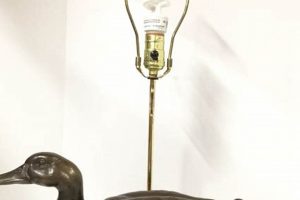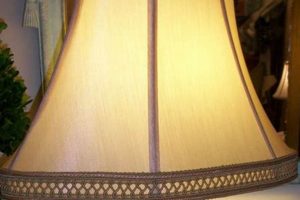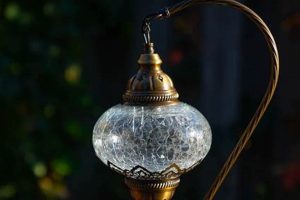Illuminating devices from a bygone era, these artifacts represent a convergence of functionality and artistry. Characterized by their use of liquid fuel to produce light via a wick, these pieces often showcase intricate designs and diverse materials, reflecting the aesthetic sensibilities of their respective periods. Examples include Victorian-era lamps with ornate glass bases and Art Deco lamps featuring geometric patterns.
These objects hold significant value, extending beyond their practical purpose. They offer a tangible link to the past, allowing individuals to connect with historical periods and technological advancements. Furthermore, their presence provides a sense of warmth and ambiance, serving as decorative focal points that enhance interior spaces. Their historical context illuminates societal norms and technological limitations of previous generations.
An examination of these items reveals a rich tapestry of manufacturing techniques, artistic styles, and cultural influences. Further discussion will explore the specific types, identifying features, preservation methods, and the role these objects play in the current market.
Essential Considerations for Vintage Oil Lamp Enthusiasts
This section outlines several crucial points for collectors, owners, and enthusiasts seeking to understand and maintain these historical lighting devices. Careful consideration of these factors will contribute to the preservation and appreciation of these artifacts.
Tip 1: Identify Lamp Origins: Determining the manufacturer and period of a lamp is crucial for valuation and proper care. Research identifying marks, patents, and design elements to establish authenticity and historical context.
Tip 2: Assess Structural Integrity: Carefully inspect the lamp for cracks, chips, or weakened joints, especially in glass components. Prioritize repairs to prevent further damage and ensure safe operation. Seek professional assistance when necessary.
Tip 3: Use Appropriate Fuel: Employ only lamp oil specifically designed for use in oil lamps. Avoid kerosene or other fuels, as they can produce excessive smoke, odors, and potential fire hazards. Follow manufacturer recommendations for optimal performance.
Tip 4: Maintain the Wick: Regularly trim the wick to ensure a clean and even flame. A properly maintained wick minimizes smoke and maximizes light output. Replace the wick when it becomes excessively worn or charred.
Tip 5: Ensure Proper Ventilation: Operate these lamps in well-ventilated areas to prevent the accumulation of harmful fumes. Avoid placing them near flammable materials or in enclosed spaces with limited airflow.
Tip 6: Store Lamps Safely: When not in use, store lamps in a secure location, away from direct sunlight and extreme temperatures. Drain the fuel tank to prevent leaks and potential hazards during storage.
Tip 7: Practice Safe Handling: Exercise caution when handling lamps, particularly when they are lit or contain fuel. Never leave a lit lamp unattended, and keep it out of reach of children and pets.
Adhering to these guidelines promotes both the longevity of these historical pieces and the safety of their users. The information provided serves as a foundation for responsible ownership and appreciation.
The following sections will delve deeper into specific aspects, including restoration techniques and market trends, providing further insights for those engaged with these illuminating relics.
1. Historical Authenticity
Historical authenticity, in the context of vintage oil lamps, refers to the verifiable accuracy of a lamp’s origin, age, and design. Establishing authenticity is paramount for collectors, historians, and enthusiasts seeking to understand the lamp’s significance and intrinsic value.
- Original Components and Materials
The presence of original components, such as the burner, wick adjuster, chimney, and font, is a primary indicator of authenticity. The materials used, whether glass, brass, or other metals, should align with the manufacturing practices prevalent during the lamp’s purported era. Discrepancies or replacements can diminish authenticity.
- Manufacturer’s Marks and Patents
Many vintage oil lamps bear manufacturer’s marks, patent numbers, or other identifying insignia. These markings serve as crucial evidence of origin and date of manufacture. Researching these marks through historical records and databases can confirm the lamp’s authenticity and provide insights into its production context.
- Design and Stylistic Consistency
The lamp’s design and stylistic elements should correspond with the aesthetic trends and manufacturing capabilities of its claimed period. Inconsistencies, such as anachronistic features or deviations from established design norms, raise concerns about authenticity. Comparing the lamp’s design to documented examples from the era is essential.
- Provenance and Chain of Ownership
A documented provenance, tracing the lamp’s ownership history, can significantly enhance its authenticity. Information about previous owners, historical events associated with the lamp, or its inclusion in documented collections provides valuable corroboration. A well-established provenance strengthens the lamp’s historical narrative.
The verification of these aspects through expert appraisal and documentation contributes to the understanding and appreciation of vintage oil lamps. Authenticity directly impacts the desirability and monetary value of these artifacts, solidifying their role as tangible links to the past.
2. Material Composition
The materials employed in the construction of vintage oil lamps are central to understanding their history, function, and preservation. Material choices dictated production methods, influenced aesthetic qualities, and determined the lamp’s durability. Glass, brass, iron, and ceramic were common components, each contributing unique properties. For example, the use of heat-resistant glass for chimneys was essential for safety, while brass or iron offered structural support and decorative potential. Understanding these connections is crucial for assessing a lamp’s originality, identifying potential restoration needs, and accurately valuing its historical significance.
The specific alloys used in brass components, or the type of glass employed in the font, can offer clues to the lamp’s period of manufacture and geographic origin. Early lamps often used hand-blown glass, characterized by subtle imperfections and variations in thickness. Later mass-produced lamps utilized more uniform, machine-made glass. Similarly, the composition of brass alloys evolved over time, influencing their color and resistance to corrosion. Examining these material characteristics allows for a more nuanced understanding of the lamp’s history and manufacturing process. The presence of lead in glass, for instance, is a strong indicator of older manufacturing techniques.
In summary, material composition serves as a critical diagnostic tool in the study of vintage oil lamps. The choice of materials directly impacted the lamp’s functionality, aesthetics, and longevity. Careful analysis of these materials, combined with knowledge of historical manufacturing practices, enables accurate dating, authentication, and informed conservation efforts, ensuring these artifacts endure for future generations. Understanding material properties is therefore paramount for responsible collecting and preservation.
3. Manufacturing Techniques
The methods employed in crafting vintage oil lamps offer critical insights into their origin, age, and value. These techniques reflect technological advancements, regional variations, and aesthetic preferences of different eras. A comprehensive understanding of these processes is essential for collectors, historians, and enthusiasts.
- Glassblowing and Molding
The production of glass components, such as fonts and chimneys, often involved either hand-blowing or molding techniques. Hand-blown glass exhibits subtle variations in thickness and form, indicative of early manufacturing. Molded glass, introduced later, allowed for more uniform shapes and intricate designs. Identifying these differences can aid in dating and authenticating lamps. Examples include pressed glass patterns common in Victorian-era lamps versus simpler, hand-blown forms in earlier models.
- Metal Casting and Fabrication
Metal components, typically made of brass, iron, or spelter, were produced through casting, stamping, or machining. Casting allowed for the creation of complex shapes, while stamping facilitated mass production of simpler parts. The precision and finishing of metalwork can reveal the level of craftsmanship and the manufacturing scale. Intricately cast brass bases contrast with the simpler stamped metal parts found on mass-produced lamps.
- Burner Assembly and Mechanisms
The burner, a crucial functional component, involved intricate assembly of various parts, including the wick adjuster, air flow regulators, and flame spreader. The design and materials used in the burner reflect the technological advancements of the time. Early burners were often simpler in design, while later models incorporated more sophisticated mechanisms for controlling flame height and efficiency. Examples include the evolution from simple flat wick burners to more complex Argand burners.
- Finishing and Decoration
Surface finishing and decoration played a significant role in the aesthetic appeal of lamps. Techniques such as polishing, plating, painting, and enameling were used to enhance the appearance of metal and glass components. The style and quality of the finishing can provide clues to the lamp’s origin and intended market. Elaborate hand-painted designs on glass fonts contrast with simpler, mass-produced finishes on utilitarian lamps.
The manufacturing techniques employed in creating vintage oil lamps provide a tangible link to the past, reflecting the ingenuity and craftsmanship of previous generations. By examining these techniques, one can gain a deeper appreciation for the historical context and intrinsic value of these illuminating artifacts.
4. Design Aesthetics
Design aesthetics, when applied to vintage oil lamps, provides a framework for understanding the stylistic choices and artistic expressions that defined these functional objects across different historical periods. Analyzing design aesthetics offers insights into cultural values, technological capabilities, and the evolving tastes of society.
- Form and Silhouette
The overall shape and outline of a vintage oil lamp significantly contribute to its aesthetic appeal. Forms range from simple, utilitarian designs to elaborate, ornate structures. For example, the sleek, geometric forms of Art Deco lamps contrast sharply with the curvaceous, floral motifs of Victorian-era examples. These differences in form reflect distinct aesthetic preferences and manufacturing capabilities of their respective eras.
- Ornamentation and Detailing
Decorative elements, such as engravings, castings, and applied embellishments, enhance the visual interest of vintage oil lamps. The presence, type, and quality of ornamentation provide clues to the lamp’s origin, intended market, and level of craftsmanship. Examples include intricate floral patterns on Victorian glass lamps, geometric motifs on Art Deco lamps, and minimalist designs on Mid-Century Modern lamps. The level of detailing often reflects the affluence of the intended consumer base.
- Material and Color Palette
The selection of materials and the use of color contribute significantly to the aesthetic character of vintage oil lamps. The interplay of different materials, such as brass, glass, and ceramic, creates visual contrast and texture. Color palettes range from subdued, monochromatic schemes to vibrant, polychromatic designs. For instance, the use of iridescent glass in some Art Nouveau lamps creates a shimmering effect, while the combination of polished brass and clear glass in Victorian lamps conveys a sense of elegance. Material and color choices often reflected prevailing artistic trends and technological limitations.
- Stylistic Influence and Period Interpretation
Vintage oil lamps often embody specific stylistic influences, reflecting broader trends in art, architecture, and design. Identifying these influences provides a context for understanding the lamp’s aesthetic intentions. Examples include Neoclassical lamps that borrow elements from ancient Greek and Roman designs, Art Nouveau lamps that emphasize organic forms and flowing lines, and Art Deco lamps that incorporate geometric patterns and streamlined shapes. These stylistic interpretations offer insights into the cultural values and artistic sensibilities of the periods in which the lamps were created.
These design elements collectively define the aesthetic identity of vintage oil lamps, offering a tangible connection to the past. By examining the form, ornamentation, materials, and stylistic influences, one can gain a deeper appreciation for the artistic and cultural significance of these illuminating artifacts.
5. Functional Condition
The functional condition of vintage oil lamps directly impacts their value, safety, and historical representation. A lamp deemed fully functional demonstrates its original design intent, offering illumination as initially conceived by its maker. Conversely, a non-functional lamp, due to missing parts, damage, or improper assembly, loses its primary purpose, becoming primarily a decorative object. The presence of a working burner, an intact chimney, and a leak-free font are critical components. For example, a rare Victorian-era lamp with an intricate glass font loses considerable value if its original burner has been replaced with a modern substitute, or if the font leaks, rendering it unusable. Thus, functional condition serves as a key determinant of the artifact’s overall merit.
Maintaining functional condition often necessitates careful restoration. This may involve repairing or replacing damaged parts, cleaning corroded metal, or addressing issues with the wick mechanism. However, ethical restoration practices prioritize preserving original components whenever possible. Replacing a damaged but original wick adjuster with a newly manufactured one, while restoring functionality, might reduce the lamp’s historical integrity. The goal is to balance usability with the preservation of authentic materials and techniques. Museums and collectors frequently document all restoration efforts, acknowledging any replaced components to maintain transparency and provenance.
In conclusion, the functional condition of a vintage oil lamp is inextricably linked to its historical significance and practical value. It not only allows the artifact to fulfill its intended purpose but also reflects the craftsmanship and ingenuity of its creators. While restoration can improve functionality, it must be approached with careful consideration of preserving originality. Understanding the interplay between functional condition, restoration, and historical integrity ensures the responsible preservation and appreciation of these illuminating relics.
6. Rarity and Value
The correlation between rarity and value in the context of vintage oil lamps is a fundamental principle governing their market dynamics. Limited availability, whether due to low initial production numbers, low survival rates, or unique design characteristics, directly influences the perceived and actual monetary worth of these artifacts. A lamp produced in small quantities by a lesser-known manufacturer, or one featuring an unusual design element not commonly found, will generally command a higher price than a mass-produced, readily available model. This dynamic reflects the basic economic principle of supply and demand, coupled with the added allure of owning a scarce and historically significant item. The cause-and-effect relationship is evident: increased scarcity leads to heightened demand among collectors, which consequently drives up the price. Real-life examples include early kerosene lamps from the 1860s, many of which were produced in limited runs and have become highly sought after by collectors. Similarly, lamps with unique color combinations or distinctive maker’s marks often fetch premium prices at auction.
The importance of understanding the rarity-value connection extends beyond mere financial speculation. It provides a framework for appreciating the historical significance of these objects. A lamp’s rarity often reflects specific social, economic, or technological conditions of its time. For instance, a lamp produced during a period of resource scarcity or technological limitations may exhibit design or material compromises that are inherently rare and historically informative. Furthermore, the ability to assess a lamp’s rarity helps prevent overpayment and facilitates informed collecting decisions. By researching production numbers, design variations, and market trends, collectors can gain a more accurate understanding of a lamp’s true value. This knowledge is especially critical in a market where reproductions and altered lamps are prevalent.
In summary, the interplay of rarity and value is a central element in the world of vintage oil lamps. It affects pricing and drives the collection activities. Recognizing the factors that contribute to rarity enhances understanding about these historical lighting devices. Challenges include determining true rarity versus perceived scarcity. Overall, the connection between scarcity and value ensures that these rare examples are preserved.
7. Restoration Potential
Evaluating the restoration potential of vintage oil lamps is an essential aspect of collecting, preserving, and appreciating these historical artifacts. The feasibility and scope of restoration efforts directly influence the lamp’s value, functionality, and historical accuracy.
- Component Availability
The availability of replacement components, such as burners, chimneys, wicks, and fonts, significantly impacts the restoration potential. If original parts are scarce or unobtainable, the restoration may necessitate the use of reproduction components, which can affect the lamp’s authenticity and value. Conversely, if original or period-correct parts are readily available, a more accurate and valuable restoration is possible. Examples include the difficulty in sourcing original etched glass chimneys for certain Victorian-era lamps versus the relative ease of finding replacement wicks.
- Structural Integrity
The overall structural integrity of the lamp determines the extent to which restoration is feasible. Lamps with severe cracks, corrosion, or missing structural elements may be beyond reasonable restoration. Minor damage, such as small chips or surface rust, is typically manageable. Assessment involves careful examination of the lamp’s base, font, and connecting elements to determine the stability and completeness of its construction. The extent of damage to load-bearing components greatly influences the viability of a restoration project.
- Material Compatibility
When undertaking restoration, ensuring the compatibility of restoration materials with the original components is crucial. Incompatible materials can cause further damage or degrade the lamp’s historical integrity. For example, using modern adhesives on delicate glass can lead to discoloration or structural weakening. Similarly, improper cleaning agents can corrode metal finishes. Careful consideration of material compatibility is essential for preserving the lamp’s long-term stability and authenticity. Employing reversible techniques is paramount.
- Ethical Considerations
Ethical considerations play a significant role in determining the extent and methods of restoration. Prioritizing the preservation of original materials and finishes over complete restoration is a common ethical guideline. Reversibility of restoration techniques is also important, allowing for future adjustments or corrections without causing irreversible damage. Over-restoration, which involves replacing original components with modern reproductions, can diminish the lamp’s historical value. The Society of American Period Furniture Makers offers guidelines on ethical restoration.
The convergence of these factors component availability, structural integrity, material compatibility, and ethical considerations dictates the scope and viability of restoring vintage oil lamps. Evaluating these aspects allows collectors and restorers to make informed decisions, ensuring the preservation of these artifacts while respecting their historical significance. The responsible restoration approach provides functionality and preserves historical context.
Frequently Asked Questions About Vintage Oil Lamps
The following questions address common inquiries and misconceptions surrounding these historical lighting devices, providing clarity for collectors, enthusiasts, and those seeking to understand their significance.
Question 1: How can the age of a vintage oil lamp be determined?
Age determination involves examining several factors, including manufacturer’s marks, patent dates, construction materials, and stylistic design elements. Researching these attributes against historical records and design catalogs can provide a reasonable estimate of the lamp’s age.
Question 2: What are the safety precautions for operating vintage oil lamps?
Safe operation mandates using only approved lamp oil, ensuring adequate ventilation, maintaining a trimmed wick, and never leaving a lit lamp unattended. Keeping lamps away from flammable materials and out of reach of children is also crucial.
Question 3: What type of fuel is appropriate for vintage oil lamps?
Only lamp oil specifically designed for oil lamps should be used. Kerosene and other fuels pose significant safety risks due to their volatility and potential for producing excessive smoke and odors.
Question 4: How should vintage oil lamps be cleaned and maintained?
Cleaning involves using gentle, non-abrasive cleaners appropriate for the specific materials of the lamp. Regular dusting and occasional polishing of metal components help maintain their appearance. Avoid immersing lamps in water or using harsh chemicals.
Question 5: What factors influence the value of a vintage oil lamp?
Value is determined by rarity, condition, historical significance, manufacturer, design aesthetics, and the presence of original components. Lamps with documented provenance and unique features typically command higher prices.
Question 6: Are reproduction vintage oil lamps readily identifiable?
Reproduction lamps often lack the fine details, material quality, and historical accuracy of authentic vintage examples. Examining construction techniques, manufacturer’s marks, and stylistic inconsistencies can help distinguish reproductions from genuine artifacts.
Understanding these key aspects allows for informed decisions regarding the acquisition, use, and preservation of these historic objects.
The subsequent section will explore the market trends and investment potential associated with vintage oil lamps, providing further insights for collectors and enthusiasts.
Conclusion
The preceding exploration of vintage oil lamps reveals multifaceted aspects of design, manufacturing, and historical context. The assessment included component materials, functionality, and considerations for preservation and value assessment. Recognizing the diversity within the category, careful consideration of each lamp’s unique characteristics is warranted.
Continued research and diligence will ensure the longevity of these artifacts. Collectors, historians, and enthusiasts are encouraged to seek further knowledge and adopt responsible practices. Preservation efforts enhance appreciation of the tangible connection to history embodied within vintage oil lamps.


![Shop Antique Vintage French Lamps - [Era/Style] Safem Fabrication - Precision Engineering & Custom Manufacturing Solutions Shop Antique Vintage French Lamps - [Era/Style] | Safem Fabrication - Precision Engineering & Custom Manufacturing Solutions](https://roopevintage.com/wp-content/uploads/2025/06/th-3858-300x200.jpg)




